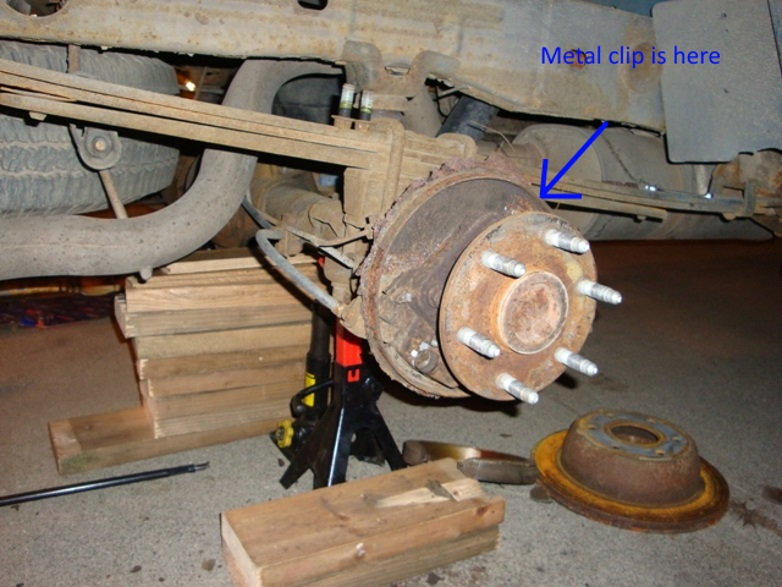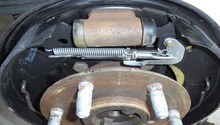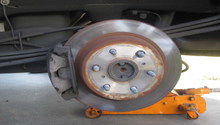Chevrolet Silverado 1999-2006: How to Replace Parking Brake
The Silverado 1500 parking brake uses a one piece shoe that contacts the inner side of the rear rotors. It's adjustable, but eventually all the friction material on the shoe will wear away. Learn how to replace the parking brake here.
This article applies to the Chevrolet Silverado 1500 (1999-2006).
When you press down on the parking brake pedal inside of your Silverado, a cable connected to the rear parking brake shoes moves the shoes against the brake rotor. The shoe contains friction material similar to a brake pad that keeps pressure against the rotor to keep it from spinning. The parking brake shoes are moved by a wheel cylinder that uses rods to apply the pressure. Over time the cylinder and the metal clip (holds the shoes against the backing plate) wear and can cause the shoes to bind and not apply pressure against the rotors.

Materials Needed
- Metric socket set (13mm to 21mm)
- 1/2" air or electric impact wrench
- 1/2" breaker bar (if no impact wrench is available)
- Flat head screwdriver
- Hammer
- Wire or caliper hanger
- Torque wrench
Step 1 – Raise/remove the rear wheels and support with jack stands
If you do not have an air or electric impact wrench, then you will need to loosen the lug nuts before you raise the rear wheels. Use a 21mm deep socket.
Place jack stands under the frame rails forward of the leaf springs.
(Related Article: How to Jack Up Your Truck - ChevroletForum.com)

Pro Tip
Use a block of wood between the jack stand and frame rail to eliminate damage to the frame rail.
Step 2 – Remove the rear brake calipers
There are two bolts holding the brake calipers to the rotors. They are on the backside of the caliper and they are directly above/below each other.
DO NOT let the brake caliper hang by the rubber hose. This can damage the hose. Instead, use a piece of wire or a caliper hanger and position the caliper out of the work space.

Step 3 – Remove the rear rotors
Grab both sides of the rear rotor and pull away from the wheel hub. You may need to tap the rotor in the areas indicated in Figure 3.
Once the rotor is off, check the condition of the inner rotor parking brake pad surface. If there is deep scoring or grooving, the rotor will need to be replaced.

Step 4 – Remove the parking brake shoe
The parking brake shoe is a one-piece design almost making a circle around the hub. It connects to the hub in two places. The first is at the parking brake wheel cylinder. The second is at the metal clip attached to the hub. They are at opposite sides of the parking brake shoe.
- Using a flat head screwdriver, push the parking brake shoe away from the metal clip. This creates space between the metal clip and the inner side of the brake shoe. Then grab the shoe at one end connected to the wheel cylinder and twist it out and away from the hub.
- You will need to rotate and angle the parking brake shoe to get it around and off the hub.

Figure 4. The parking brake shoe. 
Figure 5. The parking brake shoe has been removed.
Step 5 – Re-install the parking brake shoes, rotors, calipers, and wheels
- Slide the parking brake shoe around and over the hub.
- Find the metal clip again and place the inner side of the shoe against the inner side of the metal clip. This locks the shoe against the backing plate keeping it from moving forward when the emergency brake is applied.
- Then place the ends of the shoe into the slots on the sides of the wheel cylinder.
- Now that the new shoe is installed, slide the rotor back on.
- The caliper will slide right back onto the rotor. Move the caliper into the correct location to re-install the two bolts securing it to the hub.
- Now re-install the wheels and tighten the lug nuts from 100-140 ft lbs. depending on your wheel size and type.
Your truck's parking brake should now feel like new!
Related Videos
- Park Brake Shoes - Youtube.com
- How to Install/Replace Parking Brake Shoes on a Chevy Suburban - Youtube.com






